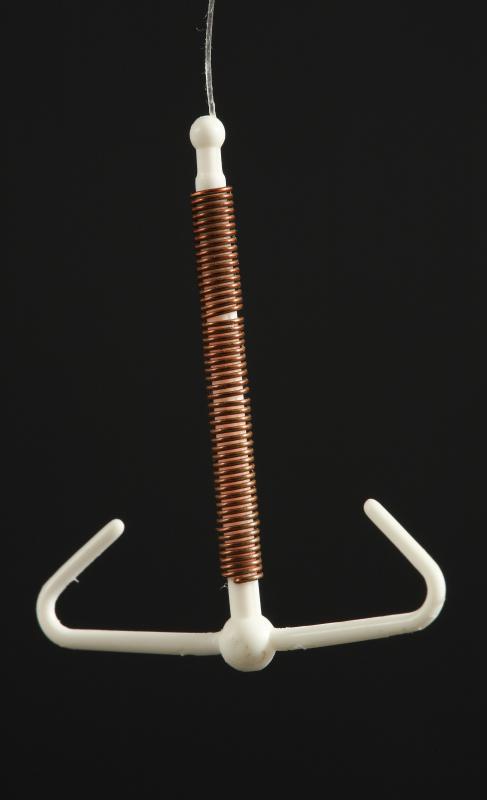At WiseGEEK, we're committed to delivering accurate, trustworthy information. Our expert-authored content is rigorously fact-checked and sourced from credible authorities. Discover how we uphold the highest standards in providing you with reliable knowledge.
What are the Most Common Non-Hormonal IUD Side Effects?
The most common non-hormonal IUD side effects are heavier bleeding and more cramping during periods for the first few months after the device is inserted. Many women also experience some cramping and bleeding between periods for the first few months after insertion. These side effects are seen with the ParaGard T intrauterine device, which is one of two IUDs available. The ParaGard IUD contains no hormones, while the Mirena IUD does contain a small amount of synthetic hormones.
For some women, non-hormonal IUD side effects include pain and fainting at the time of insertion. An IUD is a small T-shaped device, just more than 1 inch (3 cm) long that is placed in the uterus to prevent pregnancy. The ParaGard IUD is made of plastic and copper. It works by making it difficult for sperm to move, thus making it difficult for eggs to be fertilized and pregnancy to occur. Most studies find that IUDs are more than 99 percent effective, though there is some risk of the IUD being expelled from the body, which can lead to unintended pregnancies.

Other common non-hormonal IUD side effects may include backache, dizziness, and vaginal discharge. Owing to heavier menstrual bleeding associated with IUD usage, the side effects may include an increase in the risk of the woman becoming anemic. Some women may also experience an allergic reaction to the copper in the device.
While not common, some additional non-hormonal IUD side effects and complications occasionally result. On insertion, there is a rare chance that the IUD can perforate the uterus. There is also a slight risk of bacteria getting into the uterus at the time of insertion, increasing the risk of pelvic inflammatory disease for a few weeks following the insertion.

The risks of side effects or complications are increased for some women. These include women who have or are at risk for sexually transmitted disease, who have or have had ovarian cancer, and who have diabetes. Young women and women who have never been pregnant are at an increased risk of having the IUD becoming dislodged and expelled from their uterus.

While pregnancy is rare with an IUD in place, if it does occur, the woman should make an appointment to have the device removed immediately. Pregnancy with an IUD in place includes risks of pelvic infection, miscarriage, and possible birth defects. There is some risk of miscarriage at the time of the IUD's removal.
AS FEATURED ON:
AS FEATURED ON:


















Discussion Comments
The mirena causes serious damage to the female body, and the only way to get rid of these side effects for good is to remove the mirena and take natural supplements, herbs and foods and consider natural therapies that will eliminate estrogen dominance, help restore the balance of progesterone and estrogen hormones, and detoxify the body from all the toxins present in mirena such as silicone and copper.
I used to have post coital spotting which later on intensified in the form of clots. This happened after five months of my IUD insertion. I got my IUD removed immediately thinking that it was not suiting my body and something might go wrong if it was not removed in time. Since the IUD has been removed, I still have spotting since the removal which was two days ago. (there are though no clots any more). Is this normal? What do I do?
@robbie21 - I'm sorry that your friend had a bad experience, but I do think that an IUD can be a good choice for a lot of women. No method is perfect, and this kind of IUD is the most effect non hormonal birth control.
A friend of mine just got one put in - after the birth of her "oops" baby - because she hates hormonal birth control but she had gotten pregnant using condoms. (It was user error. Condoms were in another room and she didn't want to wake her sleeping toddler. Now, her birth control is always with her.)
One of the biggest barriers to IUD use has been that they're expensive. I think it will be interesting to see if they really start to catch on with more women in the US now having access to free birth control through their health insurance plans.
Another factor to be aware of as far as side effects of the IUD is that there can be problems with removing it. A friend of mine had a pregnancy scare and that made her decide to have it removed. (She decided she was not comfortable with the very low risk of birth defects or other harm to a baby should she accidentally get pregnant, as if she did, she would keep the baby.)
But it did not come out cleanly; it had evidently adhered to her uterus. The doctor's efforts to remove it resulted in it perforating her uterus and she had to have laparoscopy to remove the device. That all sounds a lot worse than it was - basically, she was sore for a couple of days - but she regretted having gotten it at all.
Post your comments